May 3rd - Girls' Night
Out
|
May 3rd - Girls' Night Out - 5-8 pm
Cedar Falls Community Main Street is sponsoring a Spring "Girls'
Night Out." At Kitchen Essentials and Gifts we are already
planning:
 Delicious refreshments and several cooking
demonstrations. Delicious refreshments and several cooking
demonstrations.
Cuisinart appliances will be featured
including panini
demonstrations by Susan Lantz.
Cuisinart appliances will be reduced in
price just for that evening.
Luann Alemao will be
making homemade ice cream,
and
A surprise from
Margaritaville (Jimmy?) |
Early Greens!
|
|


With
the new food pyramid calling for 5-9 daily servings of vegetables, a
salad, once or even twice a day, is nearly a must to meet
quota. Fortunately, the variety of salads with
spring's early greens is nearly infinite, and offers a great chance
to enjoy seasonal and local produce. Today's assortment of greens
provides a storehouse of micro-nutrients, satisfying volume, and low
calorie fuel. Served with inventive combinations
of vegetables, cheese, fruits, meats, or nuts, the nutritional
statement is balanced and guilt-free.
If you find
yourself in an iceberg, romaine, or spinach rut, break out and
explore the tender greens that are available in today's markets.
Packages of spring mix offer instant variety. It's tough to beat the
alluring texture and color exhibited by these greens.
Below is a partial primer on baby greens:
|
Mild,
possibly introverted |
Assertive,
but pleasantly so |
Strong,
with personality |
|
Boston
lettuce
Bibb lettuce
Romaine
Iceberg
Mâche
Red
Romaine
|
Baby Red
Chard
Baby Spinach
Collard Green
Green Oak
Leaf
Green Leaf Lettuce
Lolla Rosa
Red Oak Leaf
Lettuce
Red Leaf Lettuce
Tango
Red Peacock
Kale
White Peacock Kale
Pea Shoots
Red Ruby
Chard
|
Arugula
Belgian Endive
Dandelion
Greens
Frisée
Green Curly Kale
Mizuna
Tat
Soi
Watercress
Radicchio
Red Belgian Endive
Red
Mustard
|
Match the
personality of your choice in salad greens with other salad
ingredients of similar profile. Mild greens compose in subtle tones,
perfect for showcasing delicate dressings and tender toppings.
Strongly flavored or textured greens demand equally robust dressings
and accompaniments. Fresh herbs like dill,
cilantro, chervil, or parsley double nicely as tender salad greens
and flavor enhancers. |
Oil & Vinegar
|
|
When it comes to
adding dressing to our salads, it's time for a makeover. We've
developed some questionable habits of drenching our salads in
preservative-laden, artificially thickened liquid. It's time to
rediscover the culinary equivalent of "the little black
dress," that is, something classic, always
appropriate, matches everything, and easy to accessorize - olive oil
and balsamic vinegar!
Olive
Oil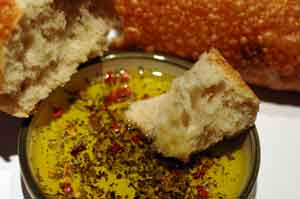
Like wine, olive
oils vary with the type of tree, where it's grown, and how it's
processed. Due to its high level of
monounsaturated fats, olive oil claims a nutritional high ground.
Used in moderation, (120 calories per tablespoon), olive oil is
universally recommended as a substitute for butter, and other
saturated fat sources. The bouquet and taste of the best olive oils
bring a dramatic advantage when dressing your salads. Olive oil
terminology is based on how it is processed, acidity level, and
taste.
Extra Virgin
Olive Oil - comes from
the first pressing of olives, acidity (oleic acid) is less than 1%,
and has superior taste.
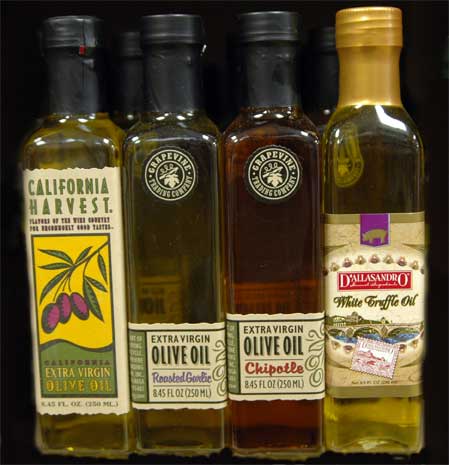 Virgin Olive Oil - naturally physically extracted olive oil,
with not more than 2% acidity, and good taste. Virgin Olive Oil - naturally physically extracted olive oil,
with not more than 2% acidity, and good taste.
Pure Olive Oil - low quality olive
oil
Cold-pressed - refers to how the olive oil has been
extracted; desirable, cold pressing indicates that no heat has been
used during extraction and processing. Heat
alters the oil affecting its composition and
taste.
Light - refers to the color of the oil, not a
lighter caloric content. Light oils are often
preferred out of habit, but actually lack positive taste and
aromatic characteristics.
Extra Light - reflects an even lighter version of light
olive oil. Again, this refers to its color and is
not necessarily desirable.
Refined-
indicates that chemical processes have been used to extract and/or
alter the taste of the olive oil.
Olive Pomace Oil - This oil results from the pomace, (ground,
previously pressed olive pulp), and represents the last oil remnants
available from the olive extracted through use of chemical solvents.
For salads, stick
with the best Extra Virgin Olive Oil that you can afford. Experiment
with different olive oils from different regions and different
producers; you'll notice and enjoy the differences.
For much more on olive oil, including hosting an olive oil tasting,
consult the Olive Oil Source
website.
Balsamic
Vinegar
We've all heard of
palate cleansers. Balsamic vinegar is a "palate awakener" and in the
process becomes a palate pleaser. The process of
making balsamic vinegar distinguishes it from wine vinegars.
Balsamics start with pressed grapes, often Trebbiano
grapes. The liquid is reduced by 50% over an open
flame (think maple syrup) and a "must" is created.
Older balsamic vinegar is added to the must (think sourdough
starter) and the liquid is set to age in wooden casks.
Flavor complexity is imparted through transfer of the liquid
over time to casks made of different types of woods, such as oak,
cherry, ash, mulberry, and others. The exact woods, sequence, and timing of these
transfers is a proprietary secret.
Aging the vinegar
adds magic to the balsamic's syrupy, tangy, yet somehow sweet
character, resulting in an incredibly complex flavor.
Price and quality of balsamic vinegars correlate directly
with the age of the product. Good balsamics will
note the age on the label. Three general age categories are
described as:
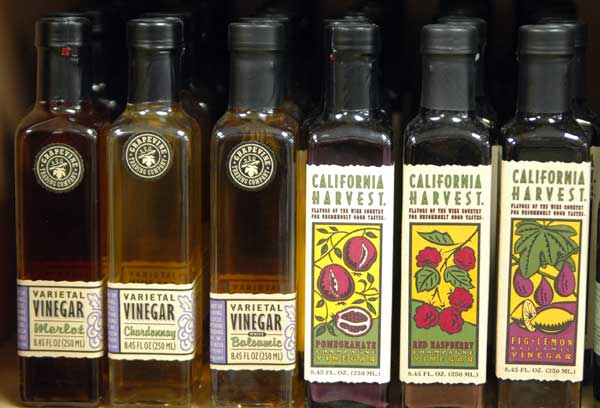 Young - aged 3-5
years; typically used in dressings Young - aged 3-5
years; typically used in dressings
Mid-Aged
- aged 6-12 years; added to sauces
Mature
- aged 12 or more, sometimes as long as 150 years!; used, literally,
only in drops.
Two regions of
Italy, Modena and Reggio, have claim to the authentic balsamic
vinegars. Some key terms associated with balsamic
vinegars are:
Tradizionale - Italian for "traditional."
This term is allowed to be used for balsamics only from
Modena or Reggio, that have been aged more than 12
years. Aceto balsamico tradizionale di
Modena, or Aceto
Balsamico Tradizionale de Reggio Emilia, designates a true, officially-sanctioned
balsamic vinegar.
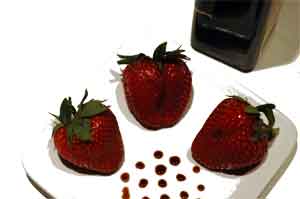 Condimento - Italian for "condiment."
This designation refers to balsamic vinegars made through the
traditional processes, but not from the Modena or Reggio Emilia
producers. Condimento - Italian for "condiment."
This designation refers to balsamic vinegars made through the
traditional processes, but not from the Modena or Reggio Emilia
producers.
Some imitators on
the market use added sugar, sulfite preservatives, a carmelization
process, or added coloring - avoid these, stick with products using
the true balsamic processing methods. These may be without a
twelve-year history, or a Modena pedigree, but used on early greens
they are still wonderful. Splurge on a tradizionale or condimento, serve it with
strawberries, or even on ice cream and you're in for an incomparable
taste sensation. |
| Assembling
& Serving |
|
Fresh is the name
of the game with salad greens! Act to preserve
freshness at every step and you will have a crisp, gorgeous-looking
dish to enjoy.
Buy
the freshest greens
possible. The leaves should be brightly-colored,
without any signs of wilting, and not bent, or torn.
Buying leaves that are as whole as possible preserves the
integrity and longevity of the food. Obviously,
reject any signs of browning or mushiness. 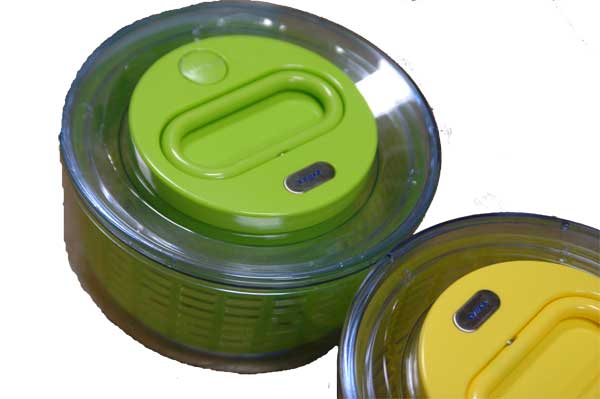
Store greens in the crisper are of your
refrigerator. The temperatures are a bit higher
in this area and protected from any cold spots that might damage the
leaves.
Wash your greens thoroughly.
Because greens are fresh produce, bacteria is always a
possibility. A salad spinner is remarkably
effective and one of the most essential tools in the kitchen for
this reason. Place the greens in the spinner,
fill with water, agitate gently to loosen any dirt or
and. Drain the water from the spinner's
bowl. Repeat until no more sediment
appears. Spin the greens. Stop
and shift the greens in the basket to uncover any hidden pockets of
water; spin again.
Dry the greens thoroughly without inducing any
wilting. A salad spinner will accomplish this
quite well, otherwise use paper towels to blot any remaining
moisture away.
Serve immediately, or store greens rolled in
paper towels up to 2 days in a plastic bag. Some
individuals store their greens by placing the entire spinner in the
refrigerator.
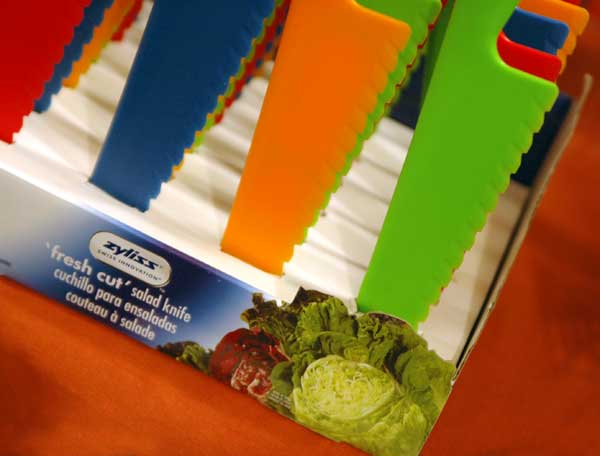 Whether
one should tear or cut the greens is a debate we won't attempt to
solve here. Ceramic or nylon knives may be a good
middle ground on this topic. Strive to strike a balance between
leaving the leaf intact for visual appeal, and sizing the pieces
appropriately for polite eating. Whether
one should tear or cut the greens is a debate we won't attempt to
solve here. Ceramic or nylon knives may be a good
middle ground on this topic. Strive to strike a balance between
leaving the leaf intact for visual appeal, and sizing the pieces
appropriately for polite eating.
Dress the greens with a vinaigrette of olive oil,
balsamic vinegar, and choice of herbs and spices. Vinaigrettes are
typically a 2:1 or 3:1 ration of olive oil to vinegar depending on
the strength of the vinegar. One tablespoon for
every two cups of greens is a good guide, however, begin by
underdressing your greens, you can always add more. Balance the
flavors of the dressing with the salad greens; mild with mild,
assertive with assertive.
Toss in a large bowl with gentle lifting motions
that do not bend or damage the leaves. Tossing distributes the
dressing effectively and reduces the quantity (and calories) needed
for a great tasting salad. 
Serve immediately.
Salad
gear comes in a great
assortment! Bamboo cutting boards, lettuce knives, salad spinners,
oil bottles, cruets, and salad tongs make great preparatory tools.
Salad service
complimenting casual or
elegant dining ranges from classic wooden bowls, salad forks, salad
serving utensils, and dressing dishes and
ladles. |
Salad Etiquette
|
|
We've all been in a
potentially awkward situation when eating a salad.
Perhaps it's the large leaf that can't be folded gracefully
onto the fork, or the vegetable scooting across the table alluding a
well-intentioned fork. Here are a few tips to
consider when eating salad:
- Make sure all pieces are
bite-size. You are not supposed to use your knife while eating
salad, but if the pieces are too large you may use the knife to
cut them bite-size.
- Any silverware that is used must
be placed on the salad plate, or on the bread and butter plate
after use.
- Cherry tomatoes in a salad
should be consumed in one bite. If you don't feel as though you
can eat it gracefully, eat around it. Refrain from cutting
it.
- Different dark greens have mild
to tangy flavors. Eat around the ones that you
don't particularly care for. The same goes for any other
ingredient that you don't care for, such as, artichokes,
cucumbers, sprouts, certain cheeses etc.
- Asking for dressing on the side
is appropriate and permissible. It is a great way to control
the portions as well.
- In a very formal situation,
salad greens are lifted onto the fork, not stabbed.
- The salad fork is usually
smaller than the entree fork and its tines are made to be able to
lift and cut greens with ease.
These tips have been graciously provided by
Luann Alemao and Associates. Check out her book,
"Grip, Grin, and Greet," now in it's second
printing! |
| Plan Ahead Tips |
|
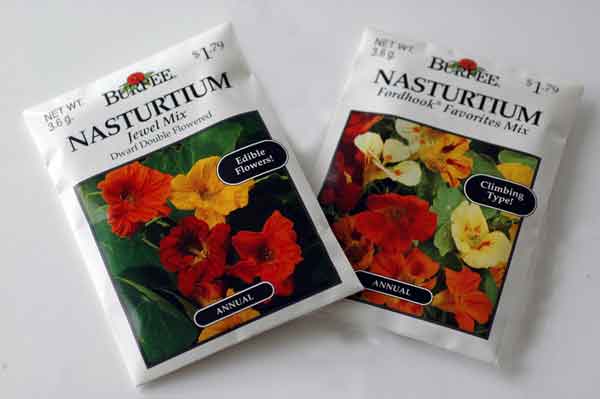 Tip
#1:
Plant nasturtiums now for a super-colorful summer
salad. Nasturtiums are one of several edible
flowers that distinguish your salad presentation while adding fun
flavors. Nasturtiums are very easy to grow, bloom incessantly in
mid-late summer, and thrive in dry soils. They
add a peppery flavor in bright yellow, oranges or reds to your
summer salads. Be mindful of the soil quality
used for the plants and avoid any chemical exposure.
Nasturtiums will thrive in containers with plenty of sun. Tip
#1:
Plant nasturtiums now for a super-colorful summer
salad. Nasturtiums are one of several edible
flowers that distinguish your salad presentation while adding fun
flavors. Nasturtiums are very easy to grow, bloom incessantly in
mid-late summer, and thrive in dry soils. They
add a peppery flavor in bright yellow, oranges or reds to your
summer salads. Be mindful of the soil quality
used for the plants and avoid any chemical exposure.
Nasturtiums will thrive in containers with plenty of sun.
Tip
#2:
Incorporate more fresh green salads in your daily life.
Working a day or two ahead of time will make this easy.
Clean and store two or three days of greens in one session.
Thorough drying will keep the greens in good condition while stored
in the refrigerator. Make a vinaigrette at the
same time, refrigerate, and use within a week. Keep small glass jars
with screw-type lids for transporting your dressing safely in your
lunch bag. |
Q
& A's
|
|
 Q: There are flavored oils
in the market; can I make my own too? Q: There are flavored oils
in the market; can I make my own too?
A: Stick with commercially
produced flavored oils. Garlic, fresh herbs,
fresh chili peppers all contain water and potentially harmful
bacteria. When immersed and stored, the oil forms
an airtight environment perfect for anaerobic bacteria, like
botulism. Commercial preparations preserve fresh
ingredients in brine or extra strong vinegar prior to inserting into
the oil. Dried ingredients, or essential herbal
or spice oils may be used to flavor oils, however, research proper
home preparation before proceeding with any method.
Q:
Bagged salads are
popular at the supermarket. Should I wash them
before serving?
A: Bagged salads offer
quick access to a wide assortment of good greens.
The preparations usually indicate "pre-washed," or
"triple-washed." We prefer to wash all greens at
home again for extra measure and to freshen the greens with
water. In the U.S., the fresh produce industry is
regulated in how it handles produce. The USDA
provides a QTV seal (Qualified Through Verification) for companies
voluntarily complying with food safety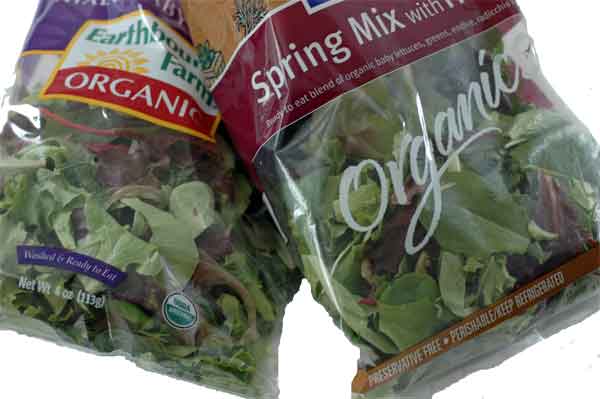 guidelines and successfully passing unannounced inspections.
Earthbound Organic Farms provides an interesting description of
safe-handling processes at their
website.
guidelines and successfully passing unannounced inspections.
Earthbound Organic Farms provides an interesting description of
safe-handling processes at their
website.
Q: How should I store my best olive
oils?
A: Store olive oil in a
glass, or plastic container that is tinted, or place in a cupboard
out of the light. Oil aging is a gradual process of
oxidation. Depending on the olive and its
processing, oils will age differently; some will be good for a year,
others for 4-5 years. Old oils are not
necessarily harmful, but they may not taste the best.
While not required, olive oil may be refrigerated to slow
down the oxidation process. When cold, crystals
may form in the oil; once warmed, the oil will return to its normal
consistency.
Q:
How should I store my
better balsamic vinegars?
A: Unlike olive oil,
balsamic vinegars may be stored for a long time.
True to its aged nature, the older, the better.
Even once a bottle is opened, exposure to oxygen will not
degrade the product. You may notice sediment in
the bottle, this is a normal part of the vinegar. Simply store in a
kitchen cupboard.
|
| Recipe |
|
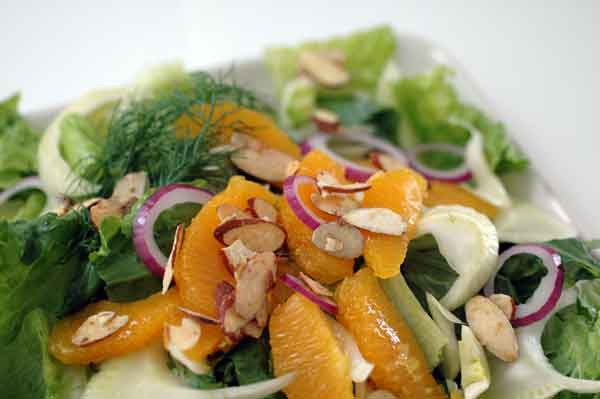 The
secret to success for a great salad is its appeal to all of our
taste sensations, savory, salty, sweet, and bitter.
By combining ingredients from the Salad Matrix below, tossing
with olive oil and balsamic vinegar, you can't miss satisfying each
taste bud. Consider the colors, textures, and
shapes as you prepare the ingredients. Add your own favorites to the
lists below. The
secret to success for a great salad is its appeal to all of our
taste sensations, savory, salty, sweet, and bitter.
By combining ingredients from the Salad Matrix below, tossing
with olive oil and balsamic vinegar, you can't miss satisfying each
taste bud. Consider the colors, textures, and
shapes as you prepare the ingredients. Add your own favorites to the
lists below.
Here are a few of
our favorite combinations:
(1)
Romaine, Fennel slices, Red Onion, Segmented Oranges,
Caramelized Almonds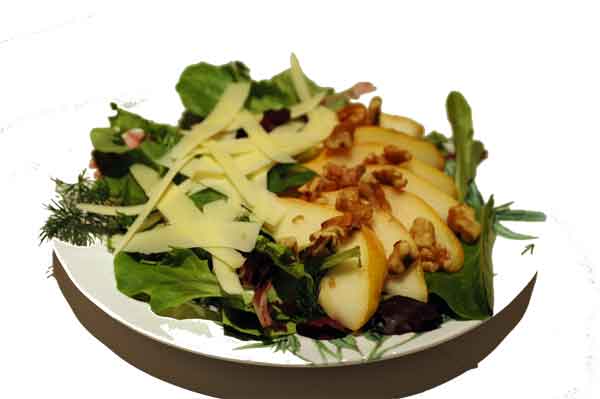
(2)
Spring Mix, Sliced Pear, Shaved Parmesan, Toasted
Walnuts
(3)
Baby Spinach, Sun-dried Julienne Tomatoes, White Cheddar,
grated, Sunflower Seeds, Grated Egg
(4)
Arugula, Red Onion, Cucumber, Dried Cranberries, Crumbled
Bleu Cheese, Grilled Chicken, Toasted Pecans
(5)
Crisp Mix, Avocado, Steamed Asparagus, Sliced Radishes,
Tuna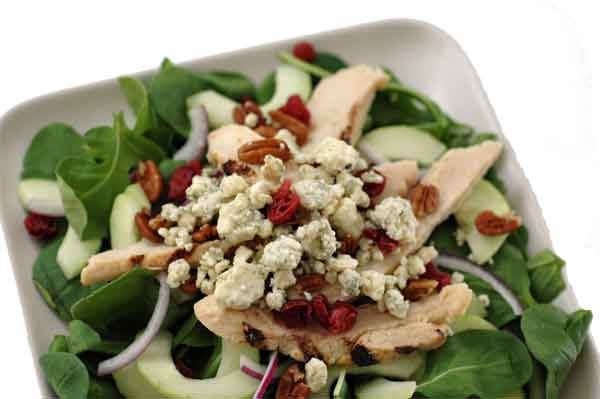
(6)
Herbs and Mixed Lettuces, Edamame, sautéed Montrachet
Medallion coated in chopped Hazelnuts
(7)
Spring Mix, Sliced Strawberries, Mango cubed, Grilled
Chicken, Toasted Walnuts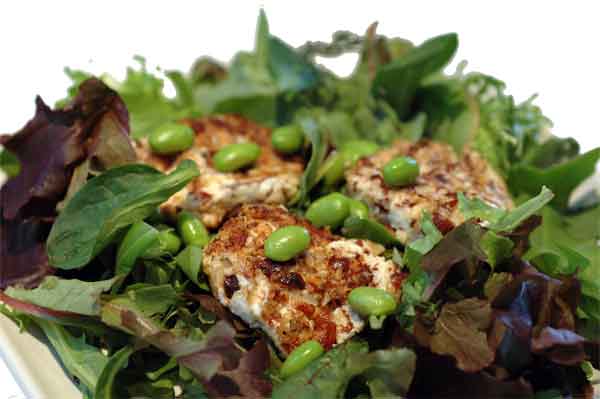
(8)
Romaine, Bell Pepper, Tomatoes, Artichoke quarters, Feta
crumbled, Red Onion, Dried Oregano, Lemon Zest, Kalamata
Olives
(9)
Leafy Lettuces (red or green), Diced Cucumber, Diced Apple,
Diced Havarti, Diced Chicken
SALAD MATRIX:
|
Greens |
Veggies |
Fruits |
Cheese |
Meats |
Nuts |
Accents |
|
Fresh |
Fresh
Steamed |
Fresh
Dried |
Cubed
Grated
Shaved
Crumbled |
Grilled
Cured
Poached |
Roasted
Caramelized |
Fresh
Pickled
Marinated |
|
Choose 1 or
mix |
Choose
2-3 |
Choose
0-2 |
Choose
0-1 |
Choose
0-1 |
Choose
0-1 |
Choose
0-2 |
|
Romaine
Bibb
Boston
Arugula
Watercress
Mâche
Red
Romaine
Basil
Dill
Chives
Parsley
Fennel
Baby
Red Chard
Baby Spinach
Collard Green
Green Oak
Leaf
Green Leaf
Lolla Rosa
Red Oak Leaf
Red Leaf
Lettuce
Tango
Red Peacock Kale
White Peacock
Kale
Pea Shoots
Red Ruby Chard
Belgian
Endive
Dandelion Greens
Frisée
Green Curly
Kale
Mizuna
Tat Soi
Watercress
Radicchio
Red
Belgian Endive
Red Mustard
|
Tomatoes
Sun-dried Tomatoes
Pea
Pods
Carrots
Radishes
Mushrooms
Bell
Pepper
Broccoli
Cucumber
Sugar
Snaps
Cauliflower
Red
Onion
Shallot
Scallions
Asparagus
Artichokes
Chickpeas
Cannellini
Beans
Fresh Peas
Water
Chesnuts
Celery
Avocado
Edamame |
Strawberries
Peaches
Raspberries
Mango
Orange
Grapefruit
Grapes
Zest
Pear
Banana
Kiwi
Papaya
Apple
Melons
Dried
Cranberries
Dried Cherries |
Bleu
cheese
Parmesan
White Cheddar
Sharp Cheddar
Goat
cheese
Feta
Havarti
Gruyere
Gorgonzola
Montrachet |
Chicken
Steak
Shrimp
Lobster
Crab
Sausage
Prosciutto
Ham
Bacon
Salmon
Tuna
Anchovies
|
Pecans
Walnuts
Pine
Nuts
Sesame
Hazelnuts
Almonds
Poppy
seeds
Peanuts
Sunflower
Seeds
Pepitas
Pistachios |
Sliced
Eggs
Grated
Eggs
Tofu
Croutons
Capers
Olives:
Kalamatas
Green
Ionian
Ripe Black
Pepperocini
| | |